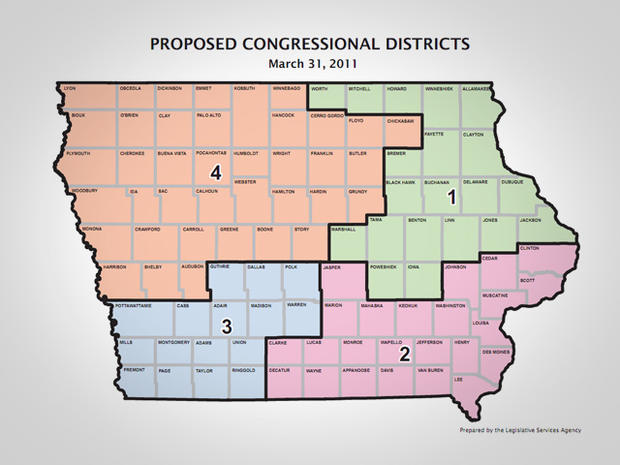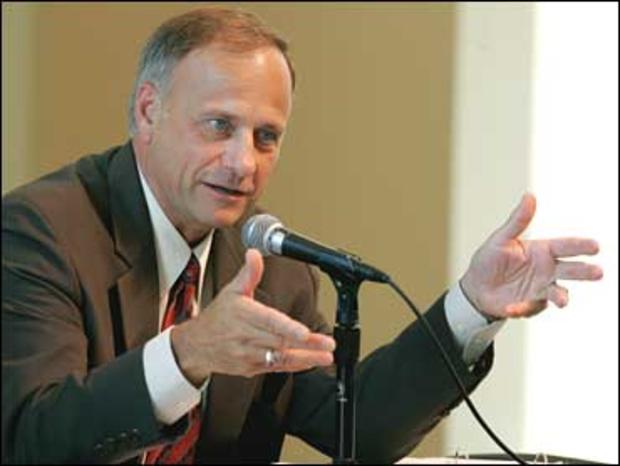Iowa House races could be among 2012's most competitive
Every 10 years, battles are waged over where to draw congressional district lines - fights that are really heating up now. In an era when most incumbents are re-elected, placement of lines in the map makes a big difference in which voters are in or out of a new district, and the result can determine control of a House seat or even of Congress.
But states vary in how they decide on the lines. Generically, the process involves a lot of partisanship on both sides.
There is an interesting case emerging now in the battleground state of Iowa, however, where a non-partisan Iowa congressional redistricting bill was signed into law earlier this week by Republican Gov. Terry Branstad. There, a bipartisan commission, rather than state legislators, construct the map. The Iowa case in an example of what can happen under such a plan, and Iowa's new districts look like they could be among the nation's more competitive ones next year.
The redistricting in the state was complicated by two factors: the change from five congressional seats to four, and the mandate that counties would be subject to division only to satisfy equal population requirements. Our analysis suggests all four districts are likely to be competitive, with potential results ranging from a three-to-one Republican map to a four-to-zero Democratic map.
Down the line, we can anticipate more marginal races than previous years in states such as California and Florida for a similar reason: both states are prohibited from utilizing partisan considerations and incumbent protection in drawing the new district lines.
Presently, the Iowa state delegation includes three Democrats: Reps. Bruce Braley (1st), Dave Loebsack (2nd) and Leonard Boswell (3rd), and two Republicans: Reps. Tom Latham (4th) and Steve King (5th). In completing its work, the Iowa commission substantially altered the boundaries in all four districts. The political reality is that at least three of them (1st, 3rd and 4th) should be competitive. Loebsack, who will move into the new 2nd district, is a probably winner there.
It is anticipated that King will run in the new 4th district, potentially opposed by Democrat Christie Vilsack, wife of former governor and U.S. Agriculture Secretary Tom Vilsack. Latham has already announced that he will challenge Democratic incumbent, Leonard Boswell, in the Des Moines-based 3rd district.
It would appear as if the Democrats hold an advantage in the Iowa construction. Braley, who survived a vigorous challenge in the old 1st district last year, will seek re-election in the new 1st district that President Obama would have won by 18 percent in 2008. Of course, Obama is likely not as popular in Iowa as he was in 2008. The new 1st district encompasses both Cedar Rapids and Waterloo. Loebsack is the favorite in the Johnson and Scott County-based 2nd district that Obama would have won by 16 percent in 2008. A better barometer might be that John Kerry's would have had a 6 percent victory margin in 2004.
A close contest is anticipated in the battle of incumbents in the 3rd district between Boswell and Latham. Des Moines dominates the district, which seemingly favors Boswell. However, the Polk County suburbs and rural counties may prefer Latham, the Republican. Obama would have won the district by 6 percent, while Kerry would have lost it by 5 percent. Initially, the district should be rated a toss-up.
Finally, the Republican-leaning 4th district could surprise. Vilsack is a potentially formidable opponent for the incumbent, King, and the district's boundareis now traverse the northern tier of the state, compared to its previous westward configuration. Obama woudd have lost the 4th by 2 percent, and Kerry would have kept the 2004 result respectable, trailing George W. Bush by 6 percent.
Bottom line: Control of the House seems competitive again in 2012. A net of 38 seats have changed from one party to the other over the past three cycles, and Democrats would need a net gain of 25 to gain control. In Iowa, two Republicans and at least one Democrat will seek re-election in marginal districts, including the 3rd district battle between two incumbents. Already, we know there will be a minimum of six margnal districts between Iowa and Arkansas, one of the other states where redistricting has been finished.
We will monitor both the likely partisan breakdown, and the likely number of competitive elections in future reports.
Mark Gersh is Washington Director of the National Committee for an Effective Congress, and a CBS News Consultant.


